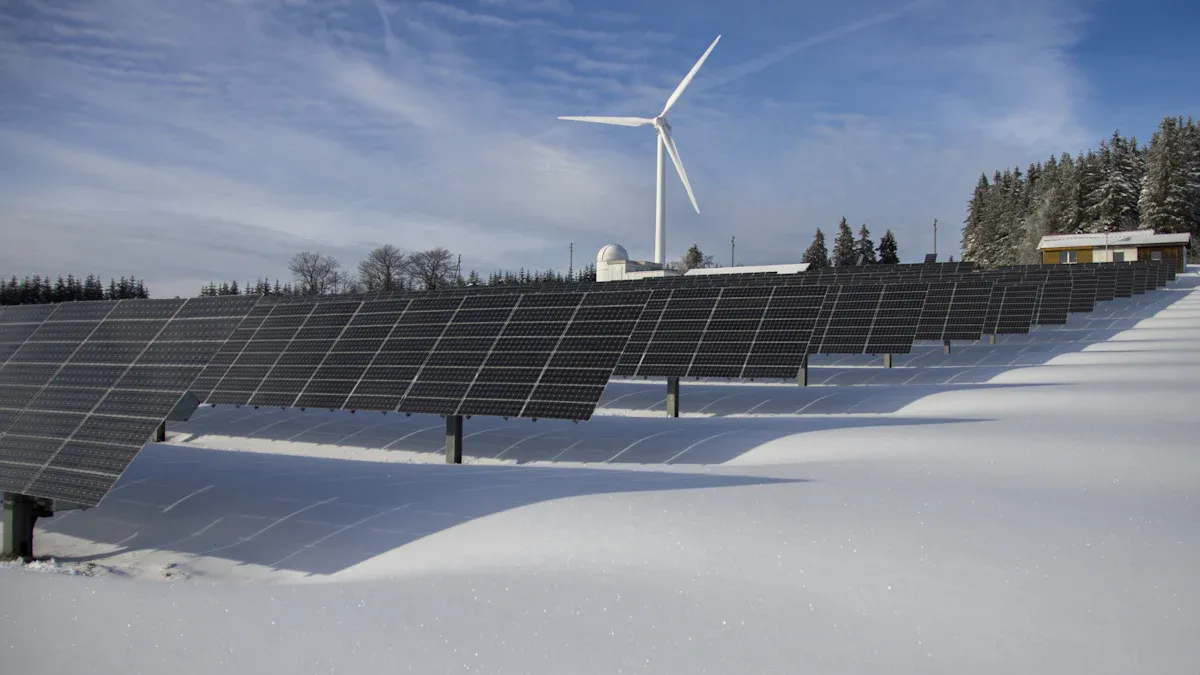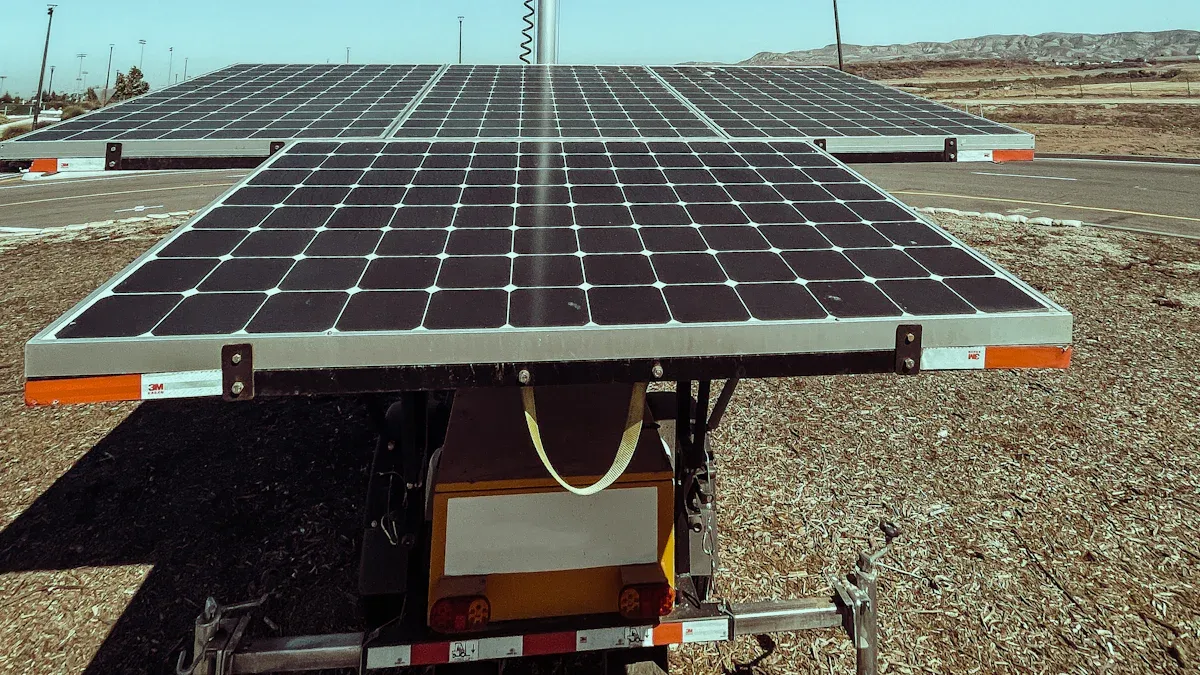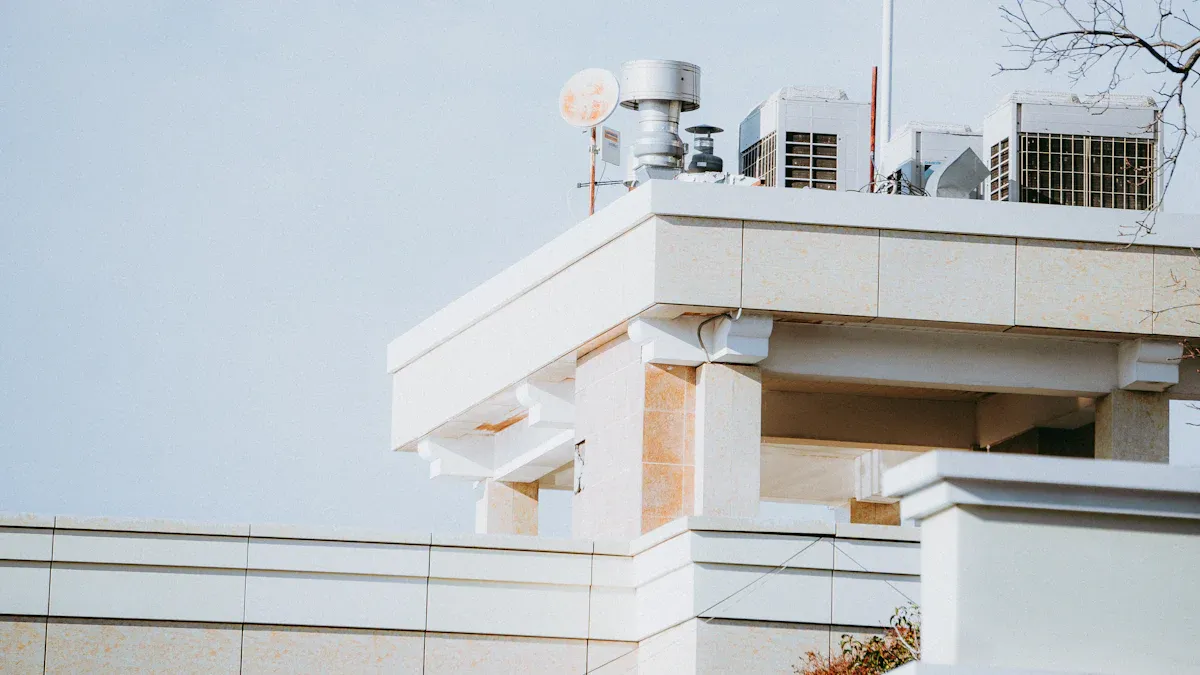Choosing the Right ESTEL PV Panel Solution for Your Telecom Cabinet

Selecting the right pv panel for telecom cabinet demands a strong focus on reliability, efficiency, and compatibility. Telecom operators often encounter challenges such as weather variability, battery degradation, and high initial cost, all of which impact the performance of telecom power solutions.
Security risks, outages, and maintenance demands further complicate energy management for telecommunications.
A high-efficiency pv panel for telecom cabinet maximizes energy output, supporting solar power for telecom and reducing long-term cost. Proven pv solutions for telecom cabinets ensure optimal solar energy use, consistent uptime, and seamless integration with telecommunications infrastructure.
Key Takeaways
Assess power needs carefully by calculating load, backup time, and battery capacity to choose the right PV panel for your telecom cabinet.
Choose durable, weatherproof PV panels with corrosion resistance and thermal management to ensure reliable operation in harsh outdoor conditions.
Match PV panels with compatible batteries, controllers, and mounting systems to maximize efficiency and simplify installation.
Consider hybrid or off-grid solar systems based on site location and grid access to balance reliability, cost, and energy independence.
Regular cleaning, inspection, and secure wiring protect your PV system, maintain efficiency, and reduce maintenance costs over time.
PV Panel for Telecom Cabinet

Power and Load Needs
Telecom operators must accurately assess the power and load requirements before selecting a pv panel for telecom cabinet. The calculation involves determining the total load in watts, estimating backup time, and applying the formula: Capacity (Ah) = Load (W) × Backup Time (h) ÷ Battery Voltage (V).
Operators should consider discharge rates and temperature effects, as these factors influence battery performance and overall system reliability.
Modular scalability allows the system to adapt to changing load demands and future expansions.
Integration of rectifiers, inverters, and power distribution units ensures effective energy management.
Thermal management and environmental protection, such as IP ratings, help maintain stable operation under varying conditions.
Compliance with regulatory standards guarantees safety and system quality.
Reliability and Durability
Outdoor telecom cabinets face harsh environmental conditions. Weatherproof sealing protects pv panels and internal electronics from rain, snow, humidity, and dust. Corrosion-resistant materials and UV protection prevent material breakdown from sun exposure. Integrated thermal management systems, including passive ventilation and active cooling, maintain stable internal temperatures. This prevents overheating, which can shorten the lifespan of pv panels. Filters block dust and contaminants, further enhancing durability. Increased temperature reduces pv panel efficiency by lowering open circuit voltage, while humidity can degrade performance through moisture ingress and reduced sunlight. Wind can cool pv cells but may also increase dust accumulation. These factors highlight the importance of robust design and regular maintenance for reliable solar energy in telecom applications.
Compatibility Factors
Integrating a pv panel for telecom cabinet requires careful attention to compatibility.
Voltage and current ratings of pv panels, charge controllers, inverters, and batteries must match, with 48V systems common in telecom.
MPPT charge controllers optimize energy flow from pv panels to batteries.
Battery selection should consider type, size, maintenance needs, and fit within the cabinet.
Secure electrical connections with weatherproof connectors and proper grounding; label wiring for safety and maintenance.
PV panel placement should maximize sunlight and avoid shading.
Monitoring tools and alert systems enable remote diagnostics and early fault detection.
Regular inspection, cleaning, and testing schedules support long-term compatibility and reliable operation.
Compatibility Issue Cause | Impact on PV Panel Installation in Telecom Cabinets | Recommended Measures |
|---|---|---|
Unstable anchorage or support structure | Affects module orientation and tilt angle, reducing light collection efficiency and potentially causing safety risks | Ensure firm, reliable, and durable anchors/brackets; control force when hanging bracket hooks for stability |
Improper distance or mounting angle | Modules may obstruct each other, reducing effective light area and lowering power generation efficiency | Maintain correct distance and angle based on module size and light requirements |
Improper selection of accessories (cables, connectors) | Leads to installation difficulties, instability, electrical problems, and safety hazards | Use high-quality, standard-compliant cables and connectors ensuring compatibility and stable operation |
Solar Power for Telecom Towers
System Types and Configurations
Telecom operators deploy several solar systems for telecom towers to ensure reliable power. The most common telecom solar power systems include off-grid solar PV setups with backup batteries, designed for remote telecom site installations. These solar systems for telecom towers operate independently from the grid, making them ideal for locations where grid access is limited or unavailable. Operators can scale and customize these systems for base transmission stations, repeater sites, and other telecom infrastructure. Key technologies in telecom solar power systems include MPPT and PWM solar charge controllers. MPPT controllers deliver higher efficiency, especially in variable sunlight, and are preferred for larger solar powered telecom towers. Hybrid solar power for telecom towers combines PV with diesel generators or wind turbines, providing additional reliability. Advanced telecom solar power systems feature remote monitoring, robust construction, and integrated energy management platforms to maximize system performance and uptime.
Urban telecom towers often rely on grid AC power, while remote towers depend on solar energy systems or wind turbines. Backup batteries and diesel generators remain essential for both, but remote sites focus on autonomy and resilience. IoT-based monitoring helps manage energy and security, especially in harsh environments.
Hybrid and Off-Grid Solutions
Operators choose between hybrid and off-grid telecom solar power systems based on site requirements. The table below compares these two approaches:
Aspect | Hybrid Solar System | Off-Grid Solar System |
|---|---|---|
Energy Source | Grid-tied with backup batteries, can draw power from grid or batteries | Fully independent, relies solely on PV and backup batteries |
Advantages | Reduces grid electricity use, expandable, future-ready, power management optimization | Complete energy independence, eco-friendly, no grid costs or outage risk |
Disadvantages | Higher upfront investment, needs specialized equipment, more space | No grid backup, risk of outages in bad weather, needs larger battery capacity |
Reliability | Grid backup ensures power during low solar generation | Risk of power loss during extended bad weather or battery depletion |
Suitability | Best for sites with grid access needing reliability and sustainability | Ideal for remote or isolated locations without grid access |
Hybrid telecom solar power systems offer flexibility and lower operational risk, while off-grid solar powered telecom towers provide full energy independence but require careful energy management and robust backup batteries.
Battery Integration
Battery integration plays a critical role in the reliability of telecom solar power systems. Backup batteries supply power during grid failures, natural disasters, or fuel shortages, ensuring continuous operation of solar powered telecom towers. Hybrid systems that combine PV, backup batteries, and generators create multi-layered redundancy, boosting system performance and resilience. Lithium-ion and Lithium Iron Phosphate (LiFePO4) batteries dominate telecom solar power systems due to their long cycle life, high energy density, and safety. These batteries support longer uptime, especially for remote telecom site installations and 5G towers. Climate-controlled enclosures and thermal management software protect batteries from temperature extremes, maintaining consistent energy delivery. Smart solar charge controllers and AI-driven analytics optimize charging and detect issues early, further enhancing reliability. Operators benefit from reduced maintenance, lower energy costs, and improved system performance when installing solar panels for cell towers with advanced battery integration.
ESTEL PV Solutions Overview
Features and Benefits
ESTEL delivers pv solutions designed for the unique demands of telecom. Each pv panel features advanced cell technology that maximizes efficiency, even in low-light conditions. Operators benefit from high conversion rates, which translate to more usable energy for telecom solar power systems. The panels use corrosion-resistant frames and tempered glass, ensuring durability in harsh environments. Integrated bypass diodes reduce power loss from shading, maintaining consistent output.
ESTEL pv panels support modular expansion. Telecom operators can scale their system as network demands grow. The design allows for easy integration with existing telecom solar power systems, reducing installation time and complexity. Each solution includes remote monitoring capabilities, enabling real-time performance tracking and early fault detection. This feature improves reliability and reduces maintenance cost.
The best solar panels for telecom towers must deliver consistent efficiency and withstand environmental stress. ESTEL’s high-quality solar panels meet international safety and quality standards. Operators experience fewer outages and lower operational cost due to the robust construction and advanced energy management features.
Model Comparison
ESTEL offers a range of pv models tailored for telecom applications. The following table compares key models, highlighting their suitability for different telecom cabinet and tower scenarios:
Model | Power Output | Efficiency (%) | Dimensions (mm) | Weight (kg) | Best Use Case |
|---|---|---|---|---|---|
ESTEL Compact | 150W | 19.5 | 1200 x 540 | 9 | Small telecom cabinets, space-limited |
ESTEL Standard | 250W | 20.1 | 1640 x 992 | 18 | Medium telecom towers, hybrid systems |
ESTEL High-Eff | 400W | 21.8 | 2000 x 1000 | 22 | Large telecom towers, off-grid sites |
Operators seeking the best solar panels for telecom towers often select the ESTEL High-Eff model for its superior efficiency and output. The Compact model fits smaller telecom cabinets where space is limited. The Standard model balances efficiency and size, making it ideal for hybrid telecom solar power systems. Each model integrates seamlessly with battery storage and charge controllers, supporting reliable telecom operations.
Application Scenarios
ESTEL pv solutions have proven effective in diverse telecom environments. Operators deploy these systems in both urban and remote locations, achieving significant improvements in efficiency and reliability. The following real-world examples illustrate the impact of ESTEL pv solutions:
In Africa, telecom operators installed ESTEL pv systems at remote cell towers. This deployment led to a 40% reduction in energy cost for a leading Kenyan telecom provider and improved service reliability.
In India, rural telecom sites adopted ESTEL photovoltaic systems. These installations ensured uninterrupted connectivity and reduced carbon emissions, addressing energy challenges in off-grid areas.
Hybrid telecom solar power systems, combining pv with grid electricity or wind and battery storage, have been implemented in both urban and rural networks. These solutions enhanced energy reliability and lowered operational cost.
A European telecom operator adopted ESTEL’s modular solar plants, reducing its carbon footprint by 30%.
In Southeast Asia, a telecom company improved network reliability in off-grid locations using ESTEL’s hybrid solar solutions.
These scenarios demonstrate how ESTEL pv solutions deliver measurable benefits. Operators achieve lower energy cost, higher efficiency, and improved network uptime. The best solar panels for telecom towers from ESTEL adapt to various climates and site requirements, supporting the evolving needs of telecom solar power systems.
Installation and Maintenance

Mounting Options
Telecom operators select mounting systems based on site conditions and cabinet design. Rail-free mounting systems simplify solar panel installation by reducing the number of components and installation time. These systems use direct-to-deck attachment points, which protect roof integrity and minimize the risk of leaks or structural damage. Their lightweight, low-profile design reduces stress on rooftops and withstands harsh weather, extending the lifespan of pv panels. Steel mounting systems, especially those made from galvanized or stainless steel, offer long-term reliability and corrosion resistance. Operators choose galvanized steel for moderate climates and stainless steel for coastal or humid areas. Floating solar mounting systems adapt to water level changes, making them suitable for telecom sites near reservoirs. Each mounting method must comply with local regulations and consider wind and snow loads to ensure safety and consistent pv performance.
Cleaning and Upkeep
Regular cleaning and maintenance keep pv panels operating efficiently. Operators follow these best practices:
Use soft brushes or microfiber cloths to remove loose dirt.
Clean panels with mild soap and soft water, avoiding harsh chemicals.
Rinse gently with low-pressure water, below 40 PSI.
Clean during early morning or late afternoon to prevent heat damage.
Schedule cleaning every 6 to 12 months, or more often in dusty areas.
Inspect panels monthly for dirt, cracks, or damage.
Check electrical connections monthly for corrosion or looseness.
Record all maintenance in a logbook.
Operators also schedule professional inspections annually and increase maintenance if energy output drops. These steps help maintain pv efficiency and extend system lifespan.
Wiring and Security
Proper wiring and security measures protect telecom pv systems from power loss and theft. Operators use power distribution units, circuit breakers, and fuses to manage power and protect circuits. Advanced locking mechanisms and intrusion alarms deter unauthorized access. Surveillance systems, such as CCTV, enhance monitoring. Common wiring issues include poor wire management, improper splicing, loose connections, and faulty grounding. Operators prevent these problems through quality training, adherence to standards, and regular inspections. Enclosures shield equipment from environmental damage and tampering, supporting reliable pv operation.
ESTEL PV panel solutions stand out for telecom cabinets and towers due to several advantages:
High reliability and uptime, even in harsh environments
Advanced efficiency and power output, saving space and ensuring stable operation
Durable, weather-resistant construction with easy installation and maintenance
Matching the right solutions to specific telecom needs improves operational efficiency and reduces costs. Operators seeking dependable, future-ready solutions should contact ESTEL for technical consultation or a customized quote.
FAQ
What makes ESTEL PV panels suitable for telecom applications?
ESTEL PV panels use advanced cell technology and durable materials. These features ensure high efficiency and long-term reliability. Operators benefit from consistent power output and reduced maintenance needs in both urban and remote telecom sites.
How often should operators clean ESTEL PV panels?
Operators should clean PV panels every 6 to 12 months. Dusty or polluted environments may require more frequent cleaning. Regular inspections help maintain peak efficiency and extend the system’s lifespan.
Can ESTEL PV panels integrate with existing battery systems?
Yes. ESTEL PV panels support seamless integration with most industry-standard battery systems. Operators can connect panels to lithium-ion, LiFePO4, or lead-acid batteries using compatible charge controllers.
What mounting options are available for ESTEL PV panels?
ESTEL offers ground, pole, roof, and side-of-pole mounting systems. Each option provides secure installation and adapts to different site conditions. Operators select the best method based on space, climate, and cabinet design.
How do operators monitor the performance of ESTEL PV systems?
ESTEL PV solutions include remote monitoring tools. Operators track energy production, system health, and receive alerts for faults. This feature supports proactive maintenance and ensures reliable telecom network operation.
See Also
Solar Powered Energy Storage Solutions For Telecom Cabinets
A Comprehensive Guide To ESTEL Outdoor Telecom Cabinet Design
Exploring The Features Of ESTEL Telecom Cabinet Power Systems
Simple Steps For Installing ESTEL Outdoor Telecom Cabinets
Tips For Selecting The Ideal Mount For Outdoor Telecom Cabinets
CALL US DIRECTLY
86-13752765943
3A-8, SHUIWAN 1979 SQUARE (PHASE II), NO.111, TAIZI ROAD,SHUIWAN COMMUNITY, ZHAOSHANG STREET, NANSHAN DISTRICT, SHENZHEN, GUANGDONG, CHINA


